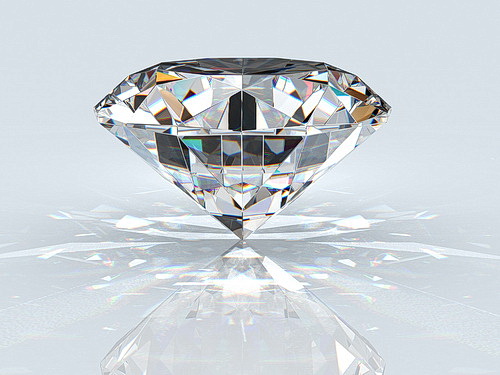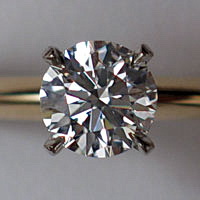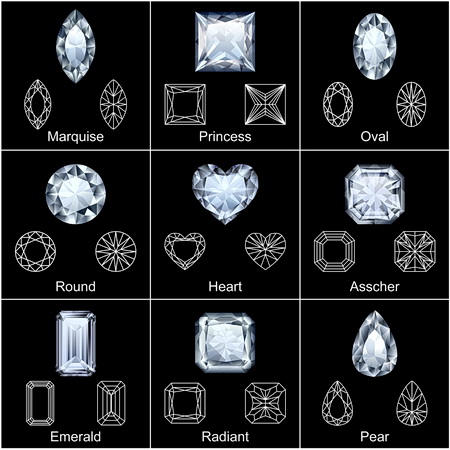
A man went to a jewelry store and requested to look at some rings for his future fiance. After several rings that were shown to him, he picked a 1-carat diamond with an emerald cut. Not being an expert in the diamond field, he purchased it for $4000.00.
A couple of years later, he told his fiance that he wanted to get her a new ring. So they went to diamond dealers to sell the current one and were told that the ring wasn’t worth more than $900.00. Frustrated, they settled for the $900.00 and left.
Why Do People Get Ripped Off When Buying Diamonds?

What was the man’s mistake?
He never asked for a GIA certificate to confirm what he was getting. “The GIA Diamond Grading Report includes an assessment of a diamond’s 4Cs – color, clarity, cut, and carat weight – along with a plotted diagram of its clarity characteristics and a graphic representation of the diamond’s proportions.”.
Of course, you can buy a diamond without a certificate and that doesn’t necessarily mean that you will get ripped off, but why take the chance?
Never buy a diamond without a GIA or equivalent certificate!

In the example above, this is a 1.5-carat diamond. It has a clarity rating of SI1 (slight imperfections, but not to the naked eye). Its color rating is H (near colorless. Yellow tint exists but is not visible).
In general, if a diamond dealer tells you they can’t give you gem grading authentication, go somewhere else.
In this article, we will find out what factors make this beloved gemstone so valuable, what to look for when you are buying one, and how it has been part of human history for so long, so let’s begin with some facts about diamonds that you should know before purchasing one.
Mined Diamonds Need Some TLC Before They Become Jewelry

Diamonds don’t come out of mines ready to be sent to the jewelry market. They go through tedious refining before a jeweler even sees them. Most of the natural diamonds from the mines never make it to that beautiful refined state because they come with too many imperfections and consequently, those diamonds are only suitable for industrial use.
Since the majority of mined diamonds can’t be used in jewelry, we are left with very few grades of diamonds that have such quality, the ones that can be used for decorative purposes, and they don’t come cheap.
It’s the simple imbalance of supply and demand that makes this gemstone expensive. However, there are additional four main characteristics that determine a diamond’s value. Let’s take a look at what each of these characteristics is.
The 4cs of Diamonds
Although the 4cs rating system is found to be the most popular among diamonds, it can apply to any mineral or gemstone, but since we are focusing on diamonds now, let’s continue using this stone as our basis for the 4c’s standard.
Color
![]()
The more colorless (or ‘whiter”) a diamond is, the rarer and more valuable it will be.
A diamond’s color is one of the determining factors regarding price. Most of the naturally occurring diamonds contain a noticeable yellowish hue.
It is hard to find one that is completely colorless; thus, the more colorless (or ‘whiter”) a diamond is, the rarer and more valuable it will be.
From an aesthetic viewpoint, as diamonds appear whiter, they give off the appearance of looking brighter to the eye and that adds a more appealing quality; therefore these diamonds automatically become more expensive.
The color or tint of diamonds is graded alphabetically. Starting with the letter “D”, which represents the most colorless of the gems; that is, one that is pure white, but this grade is hard to find. After “D” is “E” and “F”. All three of these grades are part of the colorless family and subsequently, sell for a higher price.
Then there’s “G, “H” and “J”, which represent near colorless. “K” to “M” has some faint yellow tint attributed to them and “N” to “Z” equates to a light yellower tint, but the yellow gets stronger as you move towards the end of the alphabet.
The most popular diamond color grade is “I”. When traces of the yellowish hue increase, the demand, and price of the diamond decreases.
Jewelry experts suggest getting a diamond just outside of the “D” to “F” range, such as “G” or “I” where the yellow tint may be so small you still can’t see it with the naked eye, but you can save a bundle compared to those in the “D” to “F” range.
Clarity

Diamonds are a result of carbon being exposed to intense heat and pressure under the earth’s mantle for hundreds of millions of years.
This long process can add internal and external imperfections called inclusions and blemishes. The number, size, nature, and position of these imperfections affect the clarity of the stone.
The clarity scale has six categories: flawless (FL), internally flawless (IF), very, very slightly included (VVS1 and VVS2), very slightly included (VS1 and VS2), slightly included (SI1 and SI2), and included (I1, I2, and I3). FL diamonds account for less than 1% of the current diamond supply. These are the highest-valued diamonds.
A flawless diamond (FL) is one where imperfections can’t be seen even by 10x magnification, but these diamonds are rare and subsequently, very expensive. Many diamond experts recommend that you get a diamond that has some inclusions since the price would be much less.
Diamonds rated as VS1 and VS2 will have inclusions but are not visible to the naked eye. These are a good balance when you are looking to buy a stone but don’t want to mortgage your house to get one.
Tip: The differences between VS1 and VS2 are hardly noticeable, so it may be worth your while to purchase a diamond with a VS2 rating and save some money.
Diamonds rated SI1 have some inclusions that are, for the most part, visible under 10x magnification, but not to the naked eye, and as such, are considered the best bang for your buck. The reasoning being is that when others look at your diamond, they will visually see a flawless gem. Even though it is not flawless, no one expects them to pull out a microscope to see what it is.
Also, it should be noted that clarity is considered the least important of the diamond‘s 4c’s. This chart provides a nice illustration of diamond clarity.
A clarity of VS1 or S1 is recommended if you want to save money. They may have some imperfections but won’t be noticeable for the most part.
Cut
A cut is the most important element to consider when buying a diamond

Diamond cuts refer to proportions and not shape.
Diamonds are the only naturally occurring gemstone with a refractive index greater than 2, meaning they are very sparkly, this sparkle is called fire, which refers to the reflection of rainbow colors.
Specifically, the refractive index is the comparison between the speed of light through the air (386,000 miles/second) to the speed of light when it hits a diamond. A diamond’s refractive index rating is generally around 2. This means that light travels through a diamond approximately 2 times slower than it travels through the air, or another way of stating this is that the light bends with a refracting index of 2.
The more the bending of light, the more the fire, and of course, the more expensive it will be. But for the light to bend properly (or perfectly), it has to be cut correctly which requires the precision of a diamond cutting expert to do it right.
The better the cut, the better the fire and brightness. The cut scale contains five grades: excellent, very good, good, fair, and poor, or ideal, very good, good, poor, and low, depending upon the company that cuts.
An excellent or ideal cut allows light to enter the stone and disperse it proportionality, reflecting through the top. When a diamond’s cut is too shallow or too deep, the light will escape through the bottom of the stone.
As mentioned, mined diamonds can’t be fitted directly onto jewelry. They have to be polished and cut into a shape. Getting the perfect cut is a tricky prospect. With that said, a diamond cut is the most important element to consider when buying one. As mentioned, this is where the sparkle and fire materialize. If a diamond is not cut correctly, all the carats in the world won’t give it its flashy sparkle.
There is a tremendous balancing act involved in which the cut has to be made to enhance clarity without reducing the weight of the stone. There is always the chance that the weight and size of a diamond may be compromised while removing some visible imperfections from it.
You can learn more about diamond cuts, how light is reflected, and its relative shine here and you can learn all about the types of cuts and different types of cuts are needed here.
You can save money by purchasing a good or very good cut, as a good cut will have a decent amount of light shining from it and a very good cut will have almost as much sparkle as an Ideal cut but will cost less.
Carat
Weight
Many think that a diamond carat refers to the size when it refers to weight. As carat weight increases, so does the rarity and price of the gemstone. The larger the carat, the more expensive the diamond.
Metrically, a “carat” is defined as 200 milligrams, which is 0.2 grams or 0.0070 of an ounce, so this should give you an idea of how small a carat is. Because of the large difference in the monetary value of diamond weights, the carat is further broken down into ‘points’, where 100 points are equal to one carat or 1/100th of a carat.
In diamond social circles, one might refer to a stone that weighs 0.50 carats as a fifty-pointer. Diamonds greater than one carat are expressed in carats and decimals, so a 1.25-carat diamond would be referred to as “one point eight carats.”
A simple analogy would be that one 3-carat diamond would weigh about as much as a raisin.
When looking to buy a diamond, look for the fractional ones; such as 1.48, 2.14, or .24 carats. These would be lesser in price than purchasing a diamond with carat weights of 1.5, 2.25, or .25 respectively.
Here are some references you can use:
An F color grade with VS1 clarity would be about $10,500.
A G color grade and VS1 clarity would be around $8000.
A 1-carat engagement ring with an H color and VS2 clarity will yield around $6000.
Same ring but VS1 clarity would be $7000.
Same VS1 clarity but grade is $4,500.
So a diamond’s price with the same color grade, clarity, cut, and shape will increase significantly as the carat size increases.
Here is an excellent interactive chart that you can use to reference what the price of a diamond should be based on the factors mentioned.
More info on the 4Cs of diamonds can be found here.
Diamond Shapes

Even though diamond shapes are not a part of the 4 C’s, they will still have a major impact on the appearance of your stone and can have significant price differences depending on the current trends of the time.
Also, depending upon the shape, they reflect light differently, giving each shape its unique fire and shine.
Specifically, a diamond’s shape refers to the geometry of the diamond, while cut refers to how the diamond’s proportions reflect light, but both factors determine their sparkle, so even if you get an Ideal cut stone. you still need to know the shape that will define the gem’s brilliance for better or worse.
The shapes for diamonds are the following: Round, Princess, Marquise, Cushion, Emerald, Radiant, Pear, Oval, and Asscher.
The round cut called the round brilliant cut is the most popular shape of a diamond and is a favorite among jewelers to sell, as this cut offers great brilliance and has great flexibility within the four C’s. This means that to bring out the most brilliance in your round stone, you would want to complement it with high grades of color, clarity, and cut.
This website gives an excellent explanation of diamond shapes and how to choose the right one.
Have Diamonds Always Been so Popular and in Demand?
Diamonds have not come to the forefront from the Renaissance, agricultural, or industrial revolution. They have been important since ancient times when the Greeks ruled the world. Even the name ‘diamond’ is said to be derived from the Greek word ‘adamas’, meaning indestructible, because the Greeks associated the radiant and ever-glowing glitter of the diamond with being an indestructible sign of love.
Generally, throughout history and various civilizations, diamonds have always been considered a sign of supreme power. Many cultural dogmas consider diamonds to contain magical powers that can be used to cure madness and repel evil spirits. Plato, the famous Greek philosopher shared the thought that diamonds were living spirits. Diamond powder, due to its curing abilities, has also been used in medicines.
There are a lot more historical anecdotes that can be mentioned to highlight the fact that the diamond has always been popular. It’s this popularity that makes it so expensive.
Moving Up the Ladder
It may be noteworthy that there are jewelers with high-standing reputations such as Tiffany* who maintain their standards by selling only the perfect cut. Of course, the price may be a bit higher than a standard jeweler.
